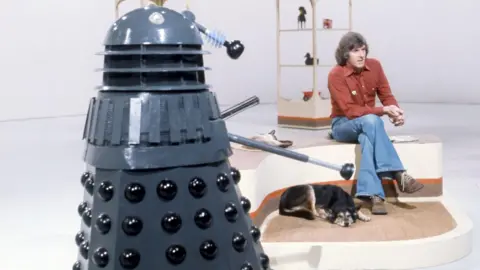Today's Doctor Who 'too sophisticated' for former star
 Paul Hayes/BBC
Paul Hayes/BBCA former Doctor Who star admitted he could not understand the stories in the current version of the BBC science-fiction series.
Peter Purves played Steven Taylor, a travelling companion of the very first Doctor, for a year from 1965.
The 86-year-old actor, who lives at Sibton in Suffolk, spoke to the BBC at the opening of a new Doctor Who exhibition at Peterborough Museum and Art Gallery, where he was the guest of honour on Saturday.
Purves said the series had become "far too sophisticated for my simple brain", but believed its production values were now much higher, with far more money being spent than when he was in it.

Purves joined the cast of the hit children's show almost 60 years ago, first appearing in a serial called The Chase in June 1965.
His character Steven was a stranded space pilot of the far future, who the original Doctor, played by William Hartnell, rescued and then shared several adventures with.
"We used to have stories that were very simple, you went from there to there, you had a cliffhanger at the end of an episode, the following week you picked up from there and went to another cliffhanger, then end of story, on to another one.
"Very simple, very straightforward, very clear and easy for kids to understand."
He said he stopped regularly watching the series in the early 1970s, when Jon Pertwee was the Doctor.
Despite Pertwee being a friend of his, Purves did not enjoy the show's format of the period, with the Doctor having been exiled to Earth and many of the stories taking place in the south of England.
"I didn't like the serials then because it got embedded in England, which lots of people think is fabulous and great, it just wasn't for me. It had lost what Doctor Who was all about."

The actor said he still kept track of the programme's cast changes to avoid any awkwardness with fellow guests at conventions.
"I try to make sure I know who's in it. If I turn up somewhere and there's someone I don't know, it could be quite embarrassing, particularly if they're a principal character."
While almost all surviving episodes of Doctor Who from 1963 onwards are now available to watch on the BBC iPlayer, Purves is not convinced it necessarily opens up the productions from his era to new generations of young viewers.
"I remember being in America at a convention and a woman came up to me and said, 'I've been trying to get my son interested in the classics, but he won't watch it because he thinks the television's broken' because you've got these black-and-white pictures."
 Paul Hayes/BBC
Paul Hayes/BBCPurves regularly fronted Doctor Who-related features when presenting the children's show Blue Peter from 1967 to 1978 but said he generally stayed away from Doctor Who conventions and events until the 1990s.
He restored his connection to the series in that decade, when he began providing linking narration for audio releases of Doctor Who episodes from his time, which no longer exist in the archives, but for which the soundtracks survive recorded by fans at home.
Despite claiming not to be able to follow the programme's current style of storytelling, Purves told the crowd watching him cut the ribbon on the new exhibition that he was impressed by Doctor Who's longevity.
"It is a remarkable thing that a series could continue to hold an audience for so long.
"And here I am – getting very old – and being able to talk about it 60 years after I first did it."
Follow Peterborough news on BBC Sounds, Facebook, Instagram and X.
